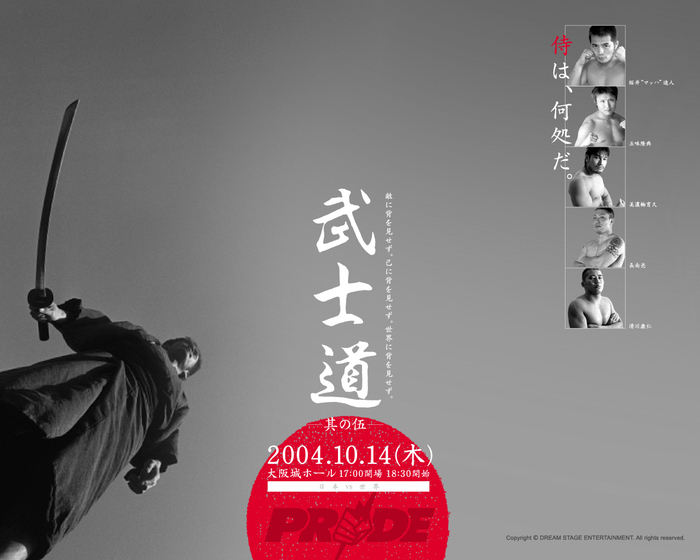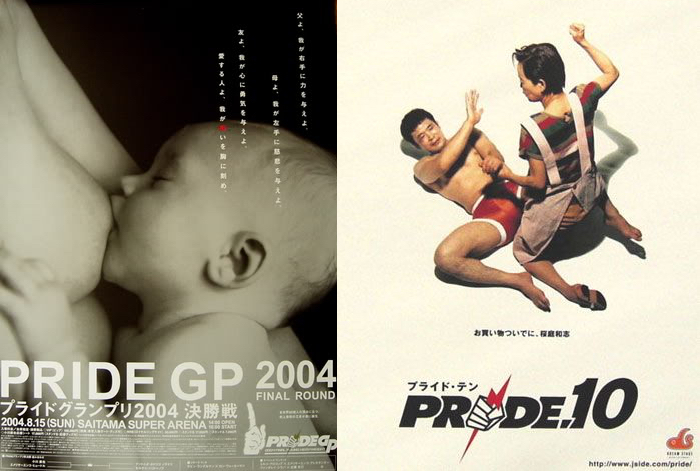PRIDE Fighting Championships is blue gloves, 10-minute rounds, and referees handing out yellow cards. PRIDE is Wanderlei Silva stomping Yuki Kondo’s head. It’s Quinton “Rampage” Jackson slamming Ricardo Arona. It’s Mirko “Cro Cop” Filipovic head-kicking a guy in a luchador mask. It’s Fedor Emelianenko nearly breaking his neck before winning moments later.
The PRIDE era was a long, violent, vital chapter of MMA history that ended a decade ago this Saturday, when the curtain fell on the aptly named PRIDE 34: Kamikaze, but the Japanese promotion made a contribution to combative sport that goes beyond simple nostalgia. While the early incarnation of the Ultimate Fighting Champion trafficked in dive-bar-brawl-on-steroids aesthetics that played up the peep-show unseemliness of no holds barred fighting, PRIDE made mixed martial arts into a comic book come to life, with tens of thousands in the audience at the Saitama Super Arena reading along.
Videos by VICE

When PRIDE FC emerged in 1997, it was a lifeline while no holds barred fighting grew ever more marginalized in North America. In the midst of the UFC’s late 1990s cable blackout, former UFC heavyweight champion Mark Coleman, Mark Kerr, Don Frye, Gary Goodridge, and their peers found better wages in Japan. As NHB became MMA, PRIDE attracted most of the era’s best fighters: Emelianenko, Rampage, Cro Cop, Wanderlei Silva, Mauricio “Shogun” Rua, Murilo Bustamante, Dan Henderson, Takanori Gomi, Paulo Filho, and too many others to count. Beyond the stomps and soccer kicks, its 10-minute opening rounds gave methodical grapplers room to breathe, and the judges’ holistic scoring system eliminated the charade of round-stealing takedowns.

In time, PRIDE nailed a balance of the high- and low-brow: grand prix tournaments with the best fighters in a division, marquee title fights, and grotesque freak show match-ups. Pride Shockwave 2004, one of the promotion’s seizure-inducing New Year’s Eve events, is a perfect case study: Emelianenko pounded the shit out of Antonio Rodrigo Nogueira in the main event, Mark Hunt landed an atomic butt drop on Wanderlei Silva, Takanori Gomi knocked out Jens Pulver, and Giant motherfucking Silva lost a ridiculous fight, as happens when you’re Giant Silva. But probably owing to its pro-wrestling ancestry, PRIDE’s audiences and promoters had an idiosyncratic outlook on MMA’s zero-sum nature, and fighting to win mattered less than fighting to entertain. Kazushi Sakuraba was a national hero not just because he beat a quartet of Gracies: it’s because he got his skull caved in by Wanderlei Silva and had the courage to do it again. And again.
Dream Stage Entertainment embellished every PRIDE event with theatrics like Sakuraba’s Super Mario Brothers-themed entrance. Fighters heard the “Crazy Pride Lady” do vocal gymnastics with their name over a PA system. Fighters became pop culture figures who occasionally shaved each other’s faces on TV commercials, and ultimately, PRIDE was a huge draw on TV and at the gate. The Saitama Super Arena routinely drew dozens of thousands of fans, and in August 2002—still essentially dark days for MMA in North America—a PRIDE and K-1 collaboration drew a record 91,000 to the Tokyo National Stadium.
Under PRIDE, fighting was playful, skull-fracturing fun with mass appeal. By comparison, the early UFC was mean-spirited, low-rent, and often boring. Fat guys gouged each other’s eyes. Tank Abbott mocked an opponent for having a seizure after he concussed him. The ring girls were on loan from the local Hooters. Tournament brackets fell apart, time limits stretched on and on, and it was all too easy to tune out. As the Zuffa-era UFC revised the image of MMA in North America and pushed forward with a sport-first mentality, PRIDE held the upper hand through better purses and sheer audacity.

It was also a product of the time. Chronic traumatic encephalopathy wasn’t a concern. Allegations of fixed fights and PRIDE’s notoriously lax attitude towards performance-enhancing drugs were cute quirks, not irresponsible and dangerous administrative defects. The sport had yet to show how thoroughly it could chew up a fighter to the point that Coleman tried to hock his 2000 Grand Prix trophy on eBay. The promotion’s behind-the-scenes connections with the Japanese mafia had yet to surface. When they did, in 2006, PRIDE lost its mainstream television presence and fell apart within a year.
After the UFC bought PRIDE for $65 million, the migration of fighters marked an era of excitement we probably won’t see again: the long-running debate over which promotion had the better fighters would find resolution. It really didn’t though. Rampage, Shogun, and Nogueira won championships. Dan Henderson and Mark Hunt came pretty close. Cro Cop was a bust. Emelianenko never made it to the Octagon at all. It’s hard to know how many PRIDE transplants showed up to the UFC diminished by their wars in Japan, an uncomfortable five-minutes-and-10-points-at-a-time rule set, or state-sanctioned drug testing.
A decade later, however, PRIDE’s approach looks the future was firmly in the past. Rizin Fighting Federation has revived the full-blown garishness of MMA on New Year’s Eve in Japan, booking behemoth female jiu-jitsu champions against aging pro wrestlers, putting a Gracie in main events, and hosting a grand prix where Cro Cop once again emerged champion. Meanwhile, the UFC and Bellator have both swerved away from pure-sport territory, prioritizing fights based on their ability to captivate (and maybe repulse) a paying audience. The promotion’s ideology of entertainment outlives its corporeal form. Or, more bluntly, PRIDE never die.




